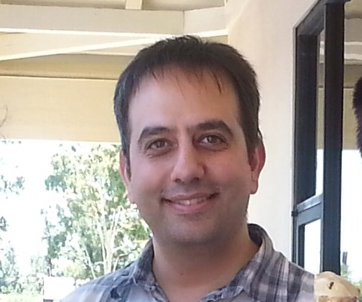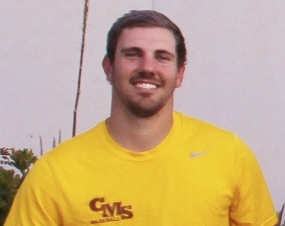By Hope Hamashige

When John Rizzo ’15 signed on to work in Babak Sanii’s laboratory, a self-assembly research laboratory at the Keck Science Department, it was in the hope of working on a research project that would help the chemistry major accomplish two things: boost his engineering chops and find a subject for his senior thesis.
As it happened, Sanii, who is assistant professor of chemistry in the Keck Science Department was hoping to find students who would be willing to build a sophisticated microscope for his laboratory. Another team of researchers was engineering lipids in his lab and, to properly analyze their work, they needed a microscope that could pivot to look at samples from upright, inverted, side-on and oblique angles. It also had to be able to convert from a brightfield microscope to a fluorescent microscope and to be capable of imaging ellipsometry.
To perform all these functions, Sanii needed three separate microscopes, which, at a cost of $360,000, was well out of his budget. His hope was that his students could build a device on a shoestring budget using commercially-available parts and their wits and brains. The result of Sanii’s needs and his students’ hard work is the SwingScope, an inexpensive, easy-to-build, ultra-sophisticated microscope. Their research was recently published in the open-access journal, PLoS One.

By the time Rizzo joined the project, another student had already started framing out the main pieces of the SwingScope and so Sanii charged Rizzo with spearheading the construction of the imaging ellipsometry system, a task that Rizzo found daunting at first.
“I had no idea where to start because I didn’t know what imaging ellipsometry was,” said Rizzo, who was a chemistry major and pitcher for the Claremont-Mudd-Scripps baseball team during his time at CMC, and went on to study chemical engineering as a graduate student at Columbia University.
Sanii made it clear that he would be a guide and a sounding board, but that Rizzo’s research would be self-directed.
Rizzo’s library research revealed that imaging ellipsometry is an optical technique that measures the change in the state of polarization of the light reflected off a film’s surface to determine the properties of thin films. The technique would allow the other team in Sanii’s lab to determine materials properties of the lipids they were researching, such as their roughness or thickness or electrical conductivity.
“The components of the system were pretty simple – I needed a light, a couple of polarizers and a compensator to warp the light to a different orientation,” said Rizzo, adding that getting the components to manipulate the light in the right way and feed that image onto a camera took months of trial and error. “I had to learn a lot about light and how to manipulate it, but 90 percent of what I know now, I learned on the job in the lab.”
Learning about imaging ellipsometry was only Rizzo’s first obstacle on this project. After testing several cameras and finding that none gave the results they needed, he had to figure out a way to modify an astronomy camera to do the job.
They were forced to find creative solutions when Rizzo and his teammates could not find parts they needed. In order to make inexpensive custom made pieces, Rizzo learned to code a 3D printer to custom fit some pieces for the SwingScope. They also scoured open-source documents to find a tool, a modified PlayStation2 controller, to control the movement of the slides on the deck for optimal imaging.
“This kind of experience really showed me how to learn quickly and adapt to different situations,” said Rizzo. “It was a real life experience and one that most undergrads don’t get because they don’t all get to do research. Working on this project was an incredible and defining moment in my life and I encourage all future science students to pursue research if given the opportunity.”
Today, Sanii’s laboratory has the microscope that he wanted and for a modest $16,000. And, because of this sophisticated and inexpensive device that one group of his students made, another group of young scientists studying lipids using this microscope were able to publish the results of their research in a recent edition of the journal, Soft Matter.

